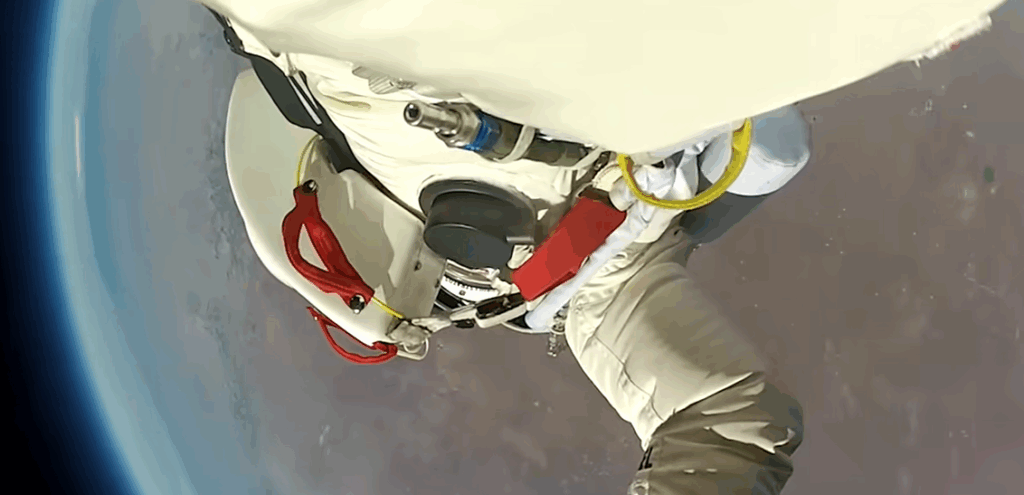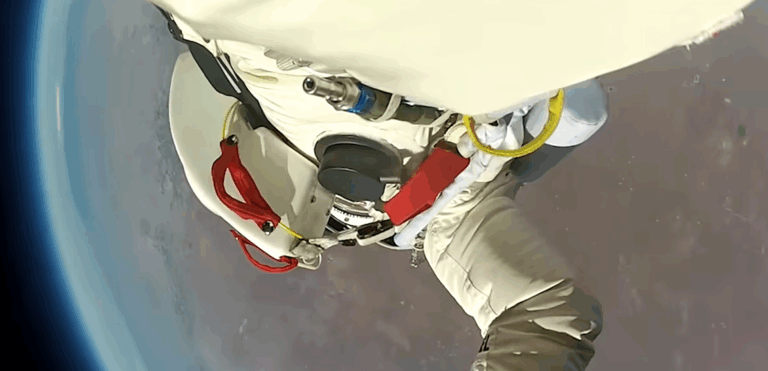Felix Baumgartner’s jump from 2012 is still regarded as one of the most incredible human accomplishments ever. He used a skyscraper-sized balloon filled with helium to launch himself into the stratosphere by reaching a height of 127,852 feet, or about 24 miles above sea level. Officially measured at 38,969.4 meters, that jump height was not only a risky stunt but also a well-thought-out scientific experiment that had a significant influence on aerospace research.
Few events in the last ten years have drawn as much attention from around the world as Felix’s fall from near space. The breathtaking simplicity of the moment he stepped out of the capsule was the only thing that could match the intensity of the anticipation, which was watched live on YouTube by over eight million people. “I’m going home now,” he said, providing a remarkably human contrast to the high-tech environment. Although the actual leap only took a little more than nine minutes, its impact is still felt in engineering, science, and even popular culture.
Baumgartner became the first person to break the sound barrier in freefall when his maximum speed during descent reached 1,357.6 km/h. That’s a lot faster than most military jets, and Felix briefly held the record for the fastest man without an engine. Because of the limitations of his pressurized suit, he did not report feeling the sonic boom; however, ground control was able to verify his speed through exceptionally clear telemetry data.
Felix went into an uncontrollable spin during the first minute of descent. He later acknowledged that the fast rotation made him afraid of fainting. Despite being extremely effective at shielding his body from atmospheric conditions, the pressure suit restricted his sensory feedback, making self-correction challenging. This unstable moment demonstrated how dangerous the entire event had been—even a small lapse in orientation could have had disastrous consequences. Nevertheless, Felix recovered control in the middle of the fall thanks to a combination of physical instinct and thorough planning.
Felix Baumgartner – Personal and Professional Profile
| Attribute | Information |
|---|---|
| Full Name | Felix Baumgartner |
| Date of Birth | April 20, 1969 |
| Place of Birth | Salzburg, Austria |
| Date of Death | July 17, 2025 (Age 56) |
| Profession | Skydiver, BASE Jumper, Daredevil |
| Known For | Red Bull Stratos Space Jump |
| Jump Height | 38,969.4 meters (127,852 feet) |
| Jump Speed | 1,357.6 km/h (843.6 mph) |
| Project Cost | Estimated $20 million |
| Reference Source | www.guinnessworldrecords.com |

Known as Red Bull Stratos, the project was especially creative. Its mission, which fused engineering, aviation, and branding, altered the public’s perception of scientific exploration. Red Bull was the private sponsor and manager of the mission, not a government space agency. This partnership wasn’t merely a show; it provided useful information that NASA and other aerospace agencies subsequently examined. Research institutions received open access to information about suit design, emergency recovery, and high-altitude physiology.
The mission made use of expert partnerships to guarantee safety and redundancy. Joe Kittinger, the former jump height record holder from 1960, was one such partner. As Baumgartner’s main contact during the mission, Kittinger, who was eighty-four, guided him through the last few minutes prior to the jump. The story gained emotional depth from the mentor-student relationship, which also showed how knowledge transfer can occur across generations in highly specialized fields.
Made from a film ten times thinner than a plastic sandwich bag, the balloon that lifted Felix into the air was incredibly effective. It took almost two hours to reach jump altitude and was as tall as the Statue of Liberty at full inflation. Weather conditions had to be tracked minute by minute on the day of launch. The balloon might have been harmed during ascent by even light winds. The Red Bull team demonstrated a painstaking attention to detail by postponing the event multiple times to guarantee maximum safety.
It’s interesting to note that Felix’s mark did not last forever, even though the jump set a record. Alan Eustace, a Google executive, broke the altitude record in 2014 by surreptitiously leaping from 135,898 feet. Baumgartner’s dive, however, is still more famous due to its dramatic effect and ability to capture the public’s imagination. Millions of people were guaranteed to witness something unprecedented—and possibly unrepeatable in that form—thanks to his prominence and Red Bull’s extensive media reach.
The data collected during the Red Bull Stratos mission has significantly improved the impact on future safety gear and space suit design. Engineers received immediate feedback on the performance of pressure suits in real-world supersonic scenarios. Emergency egress systems for pilots, astronauts, and possibly future space tourists are currently being developed with the help of that input. Felix’s contribution will probably be regarded as a seminal case study in practical safety testing in the upcoming years as suborbital travel becomes more widespread.
Following the jump, his personal life took a more grounded course, literally. Felix gave up extreme sports to pursue a career in public service and helicopter piloting. Since joining a fire department, he has helped with disaster response and aerial rescues. A larger story about maturity and purpose is reflected in that shift from daredevil to rescuer. It serves as a reminder that service and thrill-seeking are not incompatible.


